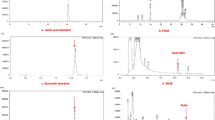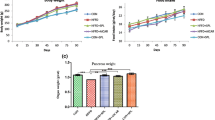Abstract
In vivo and in vitro studies suggested that chromium enhances insulin sensitivity by promoting insulin receptor signaling. However, its effect on insulin clearance has not been yet identified. Nigella sativa, a widely used spice, possesses an antidiabetic activity. We, therefore, hypothesized that chromium picolinate may alter insulin clearance by modulating insulin-degrading enzyme (IDE) in insulin-resistant rats. We evaluated also the effect of Nigella sativa oil on insulin signaling and degradation with respect to chromium picolinate. To assess these hypotheses, insulin resistance was induced in 30 male Wistar albino rats through daily oral administration of high-fructose water (HFW, 20% w/v) for 45 days. These rats were then divided into three groups (n = 10/group). They were given either no treatment (control group) or Nigella sativa oil (500 mg/kg bw/day) or chromium picoloinate (200 μg/kg bw/day) orally along with HFW (20% w/v) for 45 days. Nigella sativa oil or chromium picolinate concurrent administration with HFW significantly decreased body weight, serum lipids, glucagon, insulin resistance, and hepatic IDE level but increased its mRNA expression and insulin receptor phosphorlyation as well as high-density lipoprotein cholesterol (HDL-C) level as compared to control group values, suggesting their potential as modulators for insulin signaling and clearance. However, Nigella sativa oil exerted better improvement in feeding efficacy ratio as well as the levels of glucagon, insulin, insulin resistance, hepatic IDE level and insulin receptor phosphorylation than chromium picolinate, suggesting its greater insulin sensitizing capacity. Our data, for the first time, prove that Nigella sativa oil and chromium picolinate monotherapy can reduce fructose-induced insulin resistance by reduction of hepatic IDE protein and activation of insulin receptor signaling.


Similar content being viewed by others
References
Tappy L, Lê K-A (2010) Metabolic effects of fructose and the worldwide increase in obesity. Physiol Rev 90:23–46
Khitan Z, Kim DH (2013) Fructose: a key factor in the development of metabolic syndrome and hypertension. J Nutr Metab 2013. https://doi.org/10.1155/2013/682673
Ford ES (2005) Risks for all-cause mortality, cardiovascular disease, and diabetes associated with the metabolic syndrome: a summary of the evidence. Diabetes Care 28:1769–1778
Tobey TA, Mondon CE, Zavaroni I, Reaven GM (1982) Mechanism of insulin resistance in fructose-fed rats. Metabolism 31(6):608–612
Havel PJ (2005) Dietary fructose: implications for dysregulation of energy homeostasis and lipid/carbohydrate metabolism. Nutr Rev 63:133–157
Zavaroni I, Sander S, Scott S, Reaven GM (1980) Effect of fructose feeding on insulin secretion and insulin action in the rat. Metabolism 29:970–973
Corkey BE (2012) Banting lecture 2011: hyperinsulinemia: cause or consequence? Diabetes 61:4–13
Valera Mora ME, Scarfone A, Calvani M, Greca AV, Mingrona G (2003) Insulin clearance in obesity. J Am Coll Nutr 22:487–493
Shen Y, Joachimia KA, Rosner MR, Tang WJ (2006) Structures of human insulin-degradating enzyme reveal a new substrate recognition mechanism. Nature 443:870–874
Maianti JP, McFedries A, Foda ZH, Kleiner RE, Du XQ, Leissring MA, Tang WJ, Charron MJ, Seeliger MA, Saghatelian A, Liu DR (2014) Anti-diabetic activity of insulin degrading enzyme inhibitors mediated by multiple hormone. Nature 511:94–98
Saris WH, Asp NG, Björck I, Blaak E, Bornet F, Brouns F, Frayn KN, Fürst P, Riccardi G, Roberfroid M, Vogel M (1998) Functional food science and substrate metabolism. Br J Nutr 80:S47–S75
Bourgou S, Ksouri R, Bellila A, Skandrani FH, Marzouk B (2008) Phenolic composition and biological activities of Tunisia Nigella sativa L. shoots and roots. C R Biol 331:48–55
Cheikh-Rouhous S, Besbes S, Lognay G, Blecker C, Deroanne C, Attia H (2008) Sterol composition of black cumin (Nigella sativa L.) and Aleppo pine (Pinus halpensis Mill.) seed oils. J Food Compos Anal 21:162–168
Badary OA, Al-Shabana OA, Nagi MN, Al Bekairi AM, MMA E (1998) Acute and subchronic toxicity of thymoquinone in mice. Drug Dev Res 44:56–61
Mansour MA, Ginwai OT, El Hadiya T, El Khatiba AS, Al-Shabanah OA, Alsawal HA (2001) Effects of volatile oil constituents of Nigella sativa on carbon tetrachloride-induced hepatotoxicity in mice: evidence for antioxidant effects of thymoquinone. Res Commun Mol Pathol Phomacol 10:239–251
Al-Ali A, Alkawajah A, Randhawa MA, Shaikh NA (2008) Oral and intraperitoneal LD50 of thymoquinone, an active principle of Nigella sativa in mice and rats. J Ayub Med Coll Abbottabad 20:23–27
Najmi A, Nasiruddin M, Khan RA, Haque SF (2008) Effect of Nigella sativa oil on various clinical and biochemical parameters of insulin resistance syndrome. Int J Diabetes Dev Ctries 28:11–14
Ibrahim RM, Hamdan NS, Mahmud R, Imam MU, Saini SM, Rashid SN, Abd Ghafar SA, Latiff LA, Ismail M (2014) A randomised controlled trial on hypolipidemic effects of Nigella sativa seeds powder in menopausal women. J Transl Med 12:82
El-Mahmoudy A, Shimizu Y, Shiina T, Matsuyama H, El-Sayed M, Takewaki T (2005) Successful abrogation by thymoquinone against induction of diabetes mellitus with streptozotocin via nitric oxide inhibitory mechanism. Int Immunopharmacol 5:195–207
Farah KM, Atoji Y, Shimizu Y, Shiina T, Nikami H, Takewaki T (2004) Nigella sativa L. oil in streptozotocin-induced diabetic hamsters. Mechanisms of the hypoglycaemic and immunopotentiating effects. Res Vet Sci 77:123–129
Sreekanth R, Pattabhi V, Rajan SS (2008) Molecular basis of chromium insulin interactions. Biochem Biophys Res Commun 369:725–729
Jaishankar M, Tseten T, Anbalagan N, Mathew BB, Beeregowda KN (2014) Toxicity, mechanism and health effects of some heavy metals. Interdiscip Toxicol 7:60–72
Ali A, Ma Y, Reynolds J, Wise JP Sr, Inzucchi SE, Katz DL (2011) Chromium effects on glucose tolerance and insulin sensitivity in persons at risk for diabetes mellitus. Endocr Pract 17:16–25
Vincent JB (2004) Recent advances in the nutritional biochemistry of trivalent chromium. Proc Nutr Soc 63(1):41–47
Wang H, Kruszewski A, Brautigan DL (2005) Cellular chromium enhances activation of insulin receptor kinase. Biochemistry 44:8167–8175
Cefalu WT, Hu FB (2004) Role of chromium in human health and in diabetes. Diabetes Care 27:2741–2751
Wang ZQ, Yu Y, Zhang XH, Komorowski J (2014) Chromium–insulin reduces insulin clearance and enhances insulin signaling by suppressing hepatic insulin-degrading enzyme and proteasome protein expression in KKAy mice. Front Endocrinol (Lausanne) 5:1–6
Paiva AN, Lima JG, Medeiros AC, Figueiredo HA, Andrade RL, Ururahy MA, Rezende AA, Brandão-Neto J, Md A (2015) Beneficial effects of oral chromium picolinate supplementation on glycemic control in patients with type 2 diabetes: a randomized clinical study. J Trace Elem Med Biol 32:66–72
Jain SK, Kahlon G, Morehead L, Dhawan R, Lieblong B, Stapleton T, Caldito G, Hoeldtke R, Levine SN, Bass PF 3rd (2012) Effect of chromium dinicocysteinate supplementation on circulating levels of insulin, TNF-alpha, oxidative stress, and insulin resistance in type 2 diabetic subjects: randomized, double-blind, placebo-controlled study. Mol Nutr Food Res 56:1333–1341
Abdulla MH, Sattar MA, Abdullah NA, Khan Md AH, Anand Swarup KRL, Johns EJ (2011) The contribution of a1B-adrenoceptor subtype in the renal vasculature of fructose-fed Sprague–Dawley rats. Eur J Nutr 50:251–260
Mamikutty N, Thent ZC, Sapri SR, Sahruddin NN, Mohd Yusof MR, Haji Suhaimi F (2014) The establishment of metabolic syndrome model by induction of fructose drinking water in male Wistar rats. Biomed Res Int 2014:263897
Salama RH (2011) Hypoglycemic effect of lipoic acid, carnitine and Nigella sativa in diabetic rat model. Int J Health Sci (Qassim) 5:126–134
Shafik NM, Baalash A, Ebeid AM (2017) Synergistic cardioprotective effects of combined chromium picolinate and atorvastatin treatment in triton X-100-induced hyperlipidemia in rats: impact on some biochemical markers. Biol Trace Elem Res. https://doi.org/10.1007/s12011-017-1010-6
Matthews DR, Hosker JP, Rudenski AS, Naylor BA, Treacher DF, Turner RC (1985) Homeostasis model assessment: insulin resistance and beta-cell function from fasting plasma glucose and insulin concentrations in man. Diabetologia 28:412–419
Dinagaran S, Sridhar S, Eganathan P (2016) Chemical composition and antioxidant activities of black seed oil (Nigella sativa L.) IJPSR 7:4473–4479
Buettner R, Parhofer KG, Woenckhaus M, Wrede CE, Kunz-Schughart LA, Scholmerich J, Bollheimer LC (2006) Defining high-fat-diet rat models: metabolic and molecular effect of different fat types. Mol Endocrinol 36:485–501
Samuel VT (2011) Fructose induced lipogenesis: from sugar to fat to insulin resistance. Trends Endocrinol Metab 22:60–65
Sheng L, Zhou Y, Chen Z, Ren D, Cho KW, Jiang L, Shen H, Sasaki Y, Rui L (2012) NF-kappaB-inducing kinase (NIK) promotes hyperglycemia and glucose intolerance in obesity by augmenting glucagon action. Nat Med 18:943–949
Ye J (2013) Mechanisms of insulin resistance in obesity. Front Med 7:14–24
Wei X, Ke XB, Zhao XZ, Ye X, Gao Z, Ye J (2014) Regulation of insulin degrading enzyme activity by obesity-associated factors and pioglitazone in liver of diet-induced obese mice. PLoS One 9:e95399
Chandra J, Zhivotovsky B, Zaitsev S, Junti-Berggen PO, Orrenius S (2001) Role of apoptosis in pancreatic β-cell death in diabetes. Diabetes 50:S44–S47
Defronzo R (1999) Pharmacologic therapy for type 2 diabetes mellitus. Ann Intern Med 131:281–303
Giugliano D, Standl E, Vilsbøll T, Betteridge J, Bonadonna R, Campbell IW, Schernthaner GH, Staels B, Trichopoulou A, Farinaro E (2009) Is the current therapeutic armamentarium in diabetes enough to control the epidemic and its consequences? What are the current shortcomings? Acta Diabetol 46:173–181
Duck Worth WC, Bennett RG, Hamel FG (1998) Insulin degradation: progress and potential. Endocr Rev 19:608–624
Bouasla I, Bouasla A, Boumendjel A, Messarah M, Abdennour C, Boulakoud MS, El Feki A (2014) Nigella sativa oil reduces aluminium chloride-induced oxidative injury in liver and erythrocytes of rats. Biol Trace Elem Res 162:252–261
Woo CC, Kumar AP, Sethi G, Tan KH (2012) Thymoquinone: potential cure for inflammatory disorders and cancer. Biochem Pharmacol 83:443–451
Fararh KM, Shimizu Y, Shiina T, Nikami H, Ghanem MM, Takewaki T (2005) Thymoquinone reduces hepatic glucose production in diabetic hamsters. Res Vet Sci 79:219–223
Randhawa MA, Alghamdi MS, Maulik SK (2013) The effect of thymoquinone, an active component of Nigella sativa, on isoproterenol induced myocardial injury. Pak J Pharm Sci 26:1215–1219
El-Dakhakhny M, Mady N, Lembert N, Ammon HP (2002) The hypoglycemic effect of Nigella sativa oil is mediated by extrapancreatic action. Planta Med 68:465–466
Farah KM, Atoji Y, Shimizu Y, Takewaki T (2002) Isulinotropic properties of Nigella sativa oil in Streptozotocin plus Nicotinamide diabetic hamster. Res Vet Sci 73:279–282
Yoshii H, Lam TK, Gupta N, Goh T, Haber CA, Uchino H, Kim TT, Chong VZ, Shah K, Fantus IG, Mari A, Kawamori R, Giacca A (2006) Effects of portal free fatty acid elevation on insulin clearance and hepatic glucose flux. Am J Physiol Endocrinol Metab 290:E1089–E1097
Kotronen A, Juurinen L, Tikkainen M, Vehkavaara S, Yki-Järvinen H (2008) Increased liver fat, impaired insulin clearance, hepatic and adipose tissue insulin resistance in type 2 diabetes. Gastroenterology 135:122–130
Vincent JB (2015) Is the pharmacological mode of action of chromium(III) as a second messenger? Biol Trace Elem Res 166:7–12
Wang ZQ, Zhang XH, Russell JC, Hulver M, Cefalu WT (2006) Chromium picolinate enhances skeletal muscle cellular insulin signaling in vivo in obese, insulin- resistant JCR: LA-cp rats. J Nutr 136:415–420
Evans GW (1989) The effect of chromium picolinate on insulin controlled parameters in humans. Int J Biosocial Med Res 11:163–180
Rabinovitz H, Friedensohn A, Leibovitz A, Gabay G, Rocas C, Habot B (2004) Effect of chromium supplementation on blood glucose and lipid levels in type 2 diabetes mellitus elderly patients. Int J Vitam Nutr Res 74:178–182
Vincent JB (2013) Chromium: is it essential, pharmacologically relevant, or toxic? Met Ions Life Sci 13:171–198
Vincent JB (2014) Is chromium pharmacologically relevant? J Trace Elem Med Biol 28:397–405
Vincent JB (2013) The bioinorganic chemistry of chromium. John Wiley &Sons, Chichester
Author information
Authors and Affiliations
Corresponding author
Ethics declarations
Conflict of Interest
The authors declare that they have no competing interests.
Rights and permissions
About this article
Cite this article
Elseweidy, M.M., Amin, R.S., Atteia, H.H. et al. Nigella sativa Oil and Chromium Picolinate Ameliorate Fructose-Induced Hyperinsulinemia by Enhancing Insulin Signaling and Suppressing Insulin-Degrading Enzyme in Male Rats. Biol Trace Elem Res 184, 119–126 (2018). https://doi.org/10.1007/s12011-017-1167-z
Received:
Accepted:
Published:
Issue Date:
DOI: https://doi.org/10.1007/s12011-017-1167-z




